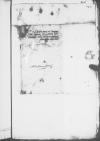Post ⌊⌋, quibus meis litteris per puerum meum missis 1545-11-02⌊die II Novembris1545-11-02⌋ respondit, Reverendissimae Dominationis Vestrae litteras nullas vidi, praeter eas, quas Thorunenis tabellarius modo reddidit. Interea nullo mihi obtingente nuntio, non videbam operae pretium, cur proprium mitterem, neque enim arbitror adeo esse evanidam Vestrae Reverendissimae Dominationis in me benevolentiam, ut crebritate litterarum retinenda vel excitanda sit, nec videbatur esse negotium, cui praecipue responderetur.
Gratus certe mihi fuit favor Reverendissimae Dominationis Vestrae in causa ecclesiae meae, cuius instructiones cum litteris ad ⌊nepotem⌋ Reverendissimae Dominationis Vestrae mox ⌊Romam⌋ misi, quamquam eventum rei optatum polliceri mihi non possum, ut sunt omnia illic invisa, illae curialium licentiae adversantur.
Quod litteris dominorum ⌊consiliariorum⌋ nihil ex aula respondetur, opinor esse in causa non tam indignationem aliquam regiam, quam quod inutilem fore nuntiorum nostrorum praesentiam, ex litteris nostris satis iam intellectum sit, verum obiurgationem non defuturam esse facile coniiciendum est.
Illustrissimum ⌊Prussiae ducem⌋ iter huc versus iam ingressum audio veneratum esse a Germaniae principibus, qui conventum ⌊Francofordi⌋ ad divi Nicolai ferias institutum nunc agere dicuntur. Cum illo reverso non omittendum est agi de multiformi suppositicia moneta, quae a vicinis quibusdam cussa invehitur ac nostris triplis et communibus grossis miscetur, bonitate quidem longe dispari, sed forma adeo simili, ut internosci a nostris vix queat. Cui manifesto stellionatui ut mature obsistatur, non solum domini ⌊ducis⌋, sed etiam totius regni et nostra omnis refert, de quo Reverendissima Dominatio Vestra cogitare velit. Si dissimulatione haec aguntur, atrocius nullum inde exspectandum est.
Ago gratias Reverendissimae Dominationi Vestrae pro impertitis novis, quamquam quae ad Brunsvicens[em] attinent, ea iam totidem verbis ante acceperam. Mitto vicissim, quae pro certis nuper ad me sunt data, alia, quae dubiae sunt fidei, omitto.
⌊Turcharum⌋ novae illae infestationes in ⌊Ungaria⌋ faciunt verisimile, quod ex ⌊Antorpio⌋ scribitur legatos ⌊Venetorum⌋ ad ⌊Turchorum imperatorem⌋ pro ratificanda quinquennali pace missos, re infecta domum rediisse, quod ille diceret se pacem illam ratam non habiturum, donec ⌊Mediolanum⌋ ⌊Gallo⌋ sit restitutum. Id si est, novam habebanus Lernam malorum.
Ex ⌊Amsterdam⌋ scribit ad me quidam non vanus XIII Novembris ⌊caesarem Carolum⌋ ⌊Gandavi⌋ esse venisseque illuc ⌊summi pontificis⌋, ⌊Franciae et Angliae regum⌋ legatos, inter quos de concordia tractari. Ad festum sancti Andreae ⌊caesarem⌋ ⌊Traiecti⌋ exspectari ibique velleris aurei distributionem futuram esse.
Si quid certius posthac habiturus sum, non omittam, quin scribam ad Reverendissimam Dominationem Vestram, cui semper commendatissimus esse cupio, optans illi cum felici exitu praesentis anni feliciorem ingressum ac successum faustissimum novi instantis.
Celare Reverendissimam Dominationem Vestram non possum, quod a fidedignis ex ⌊Italia⌋ scriptu dicitur vacantem archiepiscopatum Toletanum a ⌊caesare⌋ collatum esse ⌊Georgio episcopo Leodiensi⌋ ea condicione, ut accedente consensu ⌊papae⌋ ecclesia Leodiensis cum tota sua ditione veniat in ius caesaris. Ad haec ⌊papa⌋ concessisse ⌊imperatori⌋ medietatem fructuum omnium beneficiorum in ⌊Hispania⌋, sed a praelatis esse initam concordiam pro quarta. Item 50000 colonorum monasteriis diversis ablata ⌊caesari⌋ contulisse. Haec fortasse ex urbe Reverendissima Dominatio Vestra certius habet descripta. Quae, si vera sunt, erunt mihi exempli apud nostros.
Reverendissime Domine.
Antequam has clauderem, supervenerunt litterae magnifici domini ⌊palatini Pomeraniae⌋, quas quoniam seriae illi esse videntur, praesentibus addidi. Me quidem legentem non parum excruciarunt illae tam faciles minae de bello contra nos gerendo, quasi adempta nobis libertate pro iuribus nostris agendis. Neque tamen detrectavimus missionem ad conventum, sed consiliorum communionem negavimus iurib[us] nostris iunxi, quod nescio quomodo dominus ⌊palatinus⌋ interpretatur discessionem a privilegiis. Timeo, n[e] intestinum sit hoc malum. Cum autem etiam ipse dominus ⌊palatinus⌋ ad Reverendissimam Dominationem Vestram de his scripserit, ma... sententiam ipsius Reverendissimae Dominationis Vestrae de hac causa audire quam eius iudicium anteverto aliquid pronunciando. Non gravetur igitur ad me consilium suum scribere, ne quis dicat frustra nos admonitos esse et dormitare ad manifesta pericula. Remittat, oro, litteras Reverendissima Dominatio Vestra. Cui iterum me atque iterum commendo.
